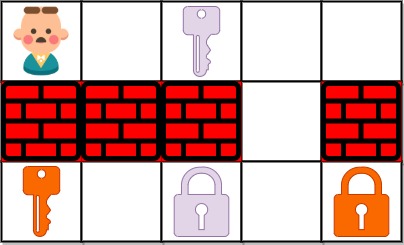【LetMeFly】864.获取所有钥匙的最短路径:广搜 + 状压 力扣题目链接:https://leetcode.cn/problems/shortest-path-to-get-all-keys/
给定一个二维网格 grid ,其中:
'.' '#' '@' 小写字母代表钥匙
大写字母代表锁
我们从起点开始出发,一次移动是指向四个基本方向之一行走一个单位空间。我们不能在网格外面行走,也无法穿过一堵墙。如果途经一个钥匙,我们就把它捡起来。除非我们手里有对应的钥匙,否则无法通过锁。
假设 k 为 钥匙/锁 的个数,且满足 1 <= k <= 6,字母表中的前 k 个字母在网格中都有自己对应的一个小写和一个大写字母。换言之,每个锁有唯一对应的钥匙,每个钥匙也有唯一对应的锁。另外,代表钥匙和锁的字母互为大小写并按字母顺序排列。
返回获取所有钥匙所需要的移动的最少次数。如果无法获取所有钥匙,返回 -1 。
示例 1:
输入: grid = ["@.a.#","###.#","b.A.B"]
输出: 8
解释: 目标是获得所有钥匙,而不是打开所有锁。
示例 2:
输入: grid = ["@..aA","..B#.","....b"]
输出: 6
示例 3:
输入: grid = ["@Aa"]
输出: -1
提示:
m == grid.lengthn == grid[i].length1 <= m, n <= 30grid[i][j] 只含有 '.', '#', '@', 'a'-'f' 以及 'A'-'F'钥匙的数目范围是 [1, 6]
每个钥匙都对应一个 不同 的字母
每个钥匙正好打开一个对应的锁
方法一:广搜 + 状压 如果不考虑钥匙和锁的问题,那么一个简单的广搜就解决了。
广搜是“走完一步能到达的位置”,然后“走完两步能到达的位置”,“……”
因此第一次搜到终点所走的步数即为答案。
本题中,增加了钥匙与锁,那么,不如把普通广搜的“位置”替换为“状态”
其中,状态包含:坐标和钥匙搜集情况
如果两次到达“同一位置”时所携带的钥匙情况不同,那么我们就认为这是“两种状态”
怎么处理钥匙收集情况呢?地图中最多有6把钥匙,因此我们可以用6位二进制数来分别代表6把钥匙。某位为1代表已获得该钥匙,0代表未获得。
这样,我们就可以把普通的广搜:
1 2 3 4 5 6 7 8 9 10 11 12 13 14 15 16 17 18 19 20 21 22 23 24 25 26 27 28 29 struct Node {int x, y;int step;push ({startX, startY, 0 });bool visited[n][m] = {false };true ;while (q.size ()) {auto [thisX, thisY, thisStep] = q.front ();pop ();for (int d = 0 ; d < 4 ; d++) {int tx = x + directions[d][0 ];int ty = y + directions[d][1 ];if (tx >= 0 && tx < n && ty >= 0 && ty < n) {if (!visited[tx][ty]) {true ;push ({tx, ty, thisStep + 1 });if (tx == targetX && ty == targetY) {return thisStep + 1 ;return -1 ;
修改为:
1 2 3 4 5 6 7 8 9 10 11 12 13 14 15 16 17 18 19 20 21 22 23 24 25 26 27 28 29 30 31 32 33 34 struct Node {int x, y;int mask; int step;push ({startX, startY, 0 , 0 });bool visited[n][m] = {false };1 << keyNum] = true ;while (q.size ()) {auto [thisX, thisY, thisMask, thisStep] = q.front ();pop ();for (int d = 0 ; d < 4 ; d++) {int tx = x + directions[d][0 ];int ty = y + directions[d][1 ];if (tx >= 0 && tx < n && ty >= 0 && ty < n) {int newMask = mask; if (isKey (grid[tx][ty])) {1 << getTh (grid[tx][ty]));if (!visited[tx][ty][newMask]) { true ;push ({tx, ty, newMask, thisStep + 1 });if (tx == targetX && ty == targetY && newMask == AllKeyMask ()) {return thisStep + 1 ;return -1 ;
说白了就是在广搜“位置”的基础上加一个“钥匙状态”
之后在广搜的过程中:
遇到“未到达过的空地”,就尝试到达(广搜)
遇到“钥匙”,就计算获得钥匙后的新状态,若“钥匙坐标&新状态”未到达过,就尝试到达(广搜)
遇到“锁”,就看当前的“钥匙状态”中是否包含这把锁的钥匙,若“包含钥匙&锁的位置状态未到达过”,就尝试到达(广搜)
广搜期间,一旦出现“获得一把钥匙后 集齐了所有的钥匙”,就返回当前步数作为答案。
广搜结束(未集齐全部钥匙)则返回-1
时间复杂度$O(nm\times k^2)$,其中$gird.size() = n\times m$,钥匙数量未$k$
空间复杂度$O(nm\times k^2)$
AC代码 C++ 1 2 3 4 5 6 7 8 9 10 11 12 13 14 15 16 17 18 19 20 21 22 23 24 25 26 27 28 29 30 31 32 33 34 35 36 37 38 39 40 41 42 43 44 45 46 47 48 49 50 51 52 53 54 55 56 57 58 59 60 61 62 63 64 65 66 67 68 69 70 71 72 73 74 75 76 77 78 79 80 81 struct MyNode {int x, y;int mask;int step;MyNode (int x, int y) : x (x), y (y), mask (0 ), step (0 ) {}const int directions[4 ][2 ] = {{-1 , 0 }, {1 , 0 }, {0 , -1 }, {0 , 1 }};class Solution {public :int shortestPathAllKeys (vector<string>& grid) int startX, startY;int cntLock = 0 ;int n = grid.size (), m = grid[0 ].size ();int key2th[26 ];for (int i = 0 ; i < n; i++) {for (int j = 0 ; j < m; j++) {if (islower (grid[i][j])) {'a' ] = cntLock++;else if (grid[i][j] == '@' ) {bool >>> visited (n, vector<vector<bool >>(m, vector <bool >(1 << cntLock, false )));push (MyNode (startX, startY));0 ] = true ;while (q.size ()) {front ();pop ();int thisX = thisNode.x, thisY = thisNode.y, thisMask = thisNode.mask;for (int d = 0 ; d < 4 ; d++) {int tx = thisX + directions[d][0 ], ty = thisY + directions[d][1 ];if (tx >= 0 && tx < n && ty >= 0 && ty < m && grid[tx][ty] != '#' ) {if (grid[tx][ty] == '.' || grid[tx][ty] == '@' ) { if (!visited[tx][ty][thisMask]) {true ;push (newNode);else if (islower (grid[tx][ty])) {int toMask = thisMask | (1 << key2th[grid[tx][ty] - 'a' ]);if (!visited[tx][ty][toMask]) {true ;push (newNode);if (toMask == (1 << cntLock) - 1 ) {return newNode.step; else if (isupper (grid[tx][ty])) {if (thisMask & (1 << key2th[grid[tx][ty] - 'A' ])) {if (!visited[tx][ty][thisMask]) {true ;push (newNode);return -1 ;
同步发文于CSDN,原创不易,转载请附上原文链接 哦~https://letmefly.blog.csdn.net/article/details/127784094


